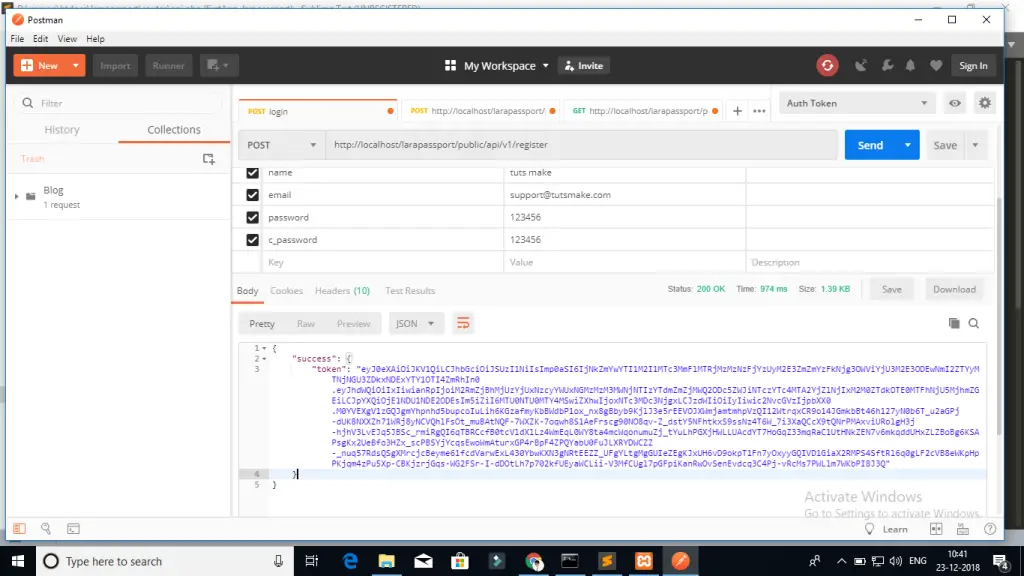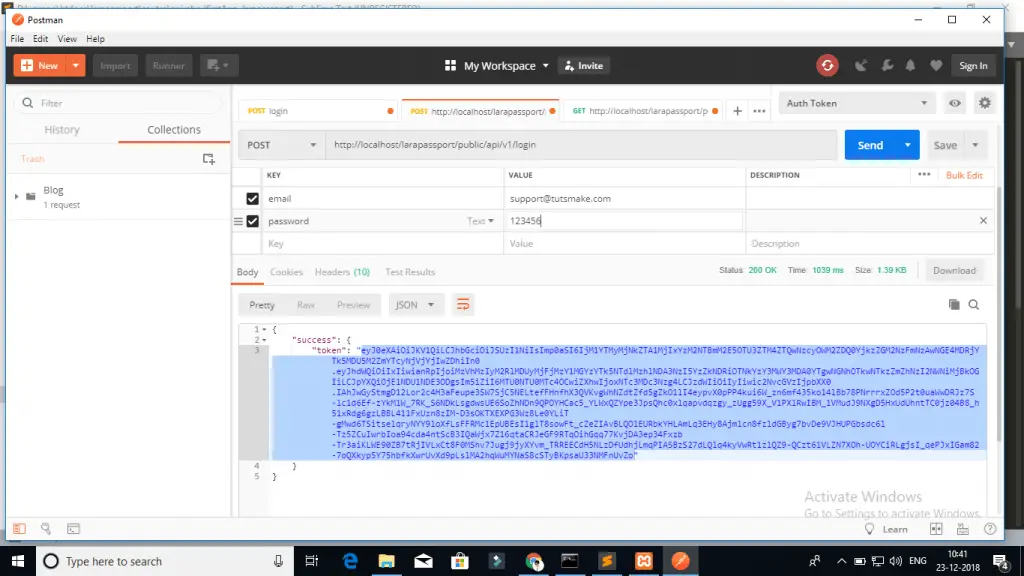Laravel 7/6 RESTful authentication APIs with passport tutorial. Here, you will learn how to create restful login, registration, get user info auth APIs in laravel with passport.
As well as, learn how to install passport auth in your laravel application and configure passport auth with laravel app.
Then, you will learn how to create restful authentication APIs using passport in laravel tutorial.
This laravel 7 passport authentication tutorial will guide on how to install passport & configure passport in laravel app. And implement a restful authentication APIs with passport in laravel app.
Laravel 7/6 Restful APIs with Passport Auth Example Tutorial
Follow the below following steps and create RESTful authentication APIs in laravel apps with passport:
- Step 1: Install Fresh Laravel Setup
- Step2: Configure Database Details
- Step 3: Install Passport Packages in Laravel
- Step 4: Run Migration and Install Passport Auth
- Step 5: Passport Configuration
- Step 6: Create APIs Route
- Step 7: Create Controller & Methods
- Step 8: Now Test Laravel REST API in Postman
Step 1: Install Fresh Laravel Setup
First of all, run the following command on your command prompt to install laravel fresh setup for building laravel 7 restful authentication Apis with passport app:
composer create-project --prefer-dist laravel/laravel blog
Step 2: Configure Database Details
Then, Navigate root directory of your installed laravel restful authentication api with passport tutorial project. And open .env file. Then add the database details as follow:
DB_CONNECTION=mysql DB_HOST=127.0.0.1 DB_PORT=3306 DB_DATABASE=here your database name here DB_USERNAME=here database username here DB_PASSWORD=here database password here
Step 3: Install Passport Package In Laravel
In this step, run the below command and install passport package :
composer require laravel/passport
After successfully install laravel passport, register providers. Open config/app.php . and put the bellow code :
// config/app.php
'providers' =>[
Laravel\Passport\PassportServiceProvider::class,
],
Before you run migration command, go to the app/providers/AppServiceProvider.php and put the two line of code inside a boot method :
Use Schema;
public function boot() {
Schema::defaultStringLength(191);
}
Step 4: Run Migration and Install Passport Auth
In this step, you need to do migration using the bellow command. This command creates tables in the database :
php artisan migrate
Now, you need to install laravel to generate passport encryption keys. This command will create the encryption keys needed to generate secure access tokens. like secret key and secret id.
php artisan passport:install
Step 5: Laravel Passport Configuration
In this step, Navigate to App folder and open User.php file. Then update the following code into User.php:
<?php namespace App; use Laravel\Passport\HasApiTokens; use Illuminate\Notifications\Notifiable; use Illuminate\Foundation\Auth\User as Authenticatable; class User extends Authenticatable use HasApiTokens, Notifiable; /** The attributes that are mass assignable. * @var array /protected $fillable = ['name', 'email', 'password',];/* The attributes that should be hidden for arrays. * @var array */ protected $hidden = [ 'password', 'remember_token', ]; }
Next Register passport routes in App/Providers/AuthServiceProvider.php, Go to App/Providers/AuthServiceProvider.php and update this line => Register Passport::routes(); inside of boot method:
<?php
namespace App\Providers;
use Laravel\Passport\Passport;
use Illuminate\Support\Facades\Gate;
use Illuminate\Foundation\Support\Providers\AuthServiceProvider as ServiceProvider;
class AuthServiceProvider extends ServiceProvider
{
/**
* The policy mappings for the application.
*
* @var array
*/
protected $policies = [
'App\Model' => 'App\Policies\ModelPolicy',
];
/**
* Register any authentication / authorization services.
*
* @return void
*/
public function boot()
{
$this->registerPolicies();
Passport::routes();
}
}
config/auth.php
Now, Navigate to config/auth.php and open auth.php file. Then Change the API driver to the session to passport. Put this code ‘driver’ => ‘passport’, in API :
[
'web' => [
'driver' => 'session',
'provider' => 'users',
],
'api' => [
'driver' => 'passport',
'provider' => 'users',
],
],
Step 6: Create APIs Route
In this step, you need to create rest API routes for laravel restful authentication apis with passport project.
So, navigate to routes folder and open api.php. Then update the following routes into api.php file:
Route::prefix('v1')->group(function(){
Route::post('login', 'Api\AuthController@login');
Route::post('register', 'Api\AuthController@register');
Route::group(['middleware' => 'auth:api'], function(){
Route::post('getUser', 'Api\AuthController@getUser');
});
});
Step 7: Create Controller & Methods
In this step, you need to create a controller name AuthController. Use the below command and create a controller :
php artisan make:controller Api\AuthController
After that, you need to create some methods in AuthController.php. So navigate to app/http/controllers/Api folder and open AuthController.php file. Then update the following methods into your AuthController.php file:
<?php
namespace App\Http\Controllers\Api;
use Illuminate\Http\Request;
use App\Http\Controllers\Controller;
use App\User;
use Illuminate\Support\Facades\Auth;
use Validator;
class AuthController extends Controller
{
public $successStatus = 200;
public function register(Request $request) {
$validator = Validator::make($request->all(),
[
'name' => 'required',
'email' => 'required|email',
'password' => 'required',
'c_password' => 'required|same:password',
]);
if ($validator->fails()) {
return response()->json(['error'=>$validator->errors()], 401); }
$input = $request->all();
$input['password'] = bcrypt($input['password']);
$user = User::create($input);
$success['token'] = $user->createToken('AppName')->accessToken;
return response()->json(['success'=>$success], $this->successStatus);
}
public function login(){
if(Auth::attempt(['email' => request('email'), 'password' => request('password')])){
$user = Auth::user();
$success['token'] = $user->createToken('AppName')-> accessToken;
return response()->json(['success' => $success], $this-> successStatus);
} else{
return response()->json(['error'=>'Unauthorised'], 401);
}
}
public function getUser() {
$user = Auth::user();
return response()->json(['success' => $user], $this->successStatus);
}
}
Lets got terminal & run the command : php artisan serve
Step 8: Now Test Laravel REST API in Postman
Here, you can see that, how to call laravel 7 restful authentication apis with passport tutorial projects:
Laravel Register Rest API :

Login API :

Next Step, you will call getUser API, In this API you have to set two headers follows:
Call login or register apis put $accessToken.
‘headers’ => [
‘Accept’ => ‘application/json’,
‘Authorization’ => ‘Bearer ‘.$accessToken,
]
Pass header in login/register rest API. it is necessary to passport authentication in laravel app
Conclusion
Laravel passport tutorial, you have learn how to install a laravel passport authentication package and also configuration passport package in laravel application. As well as using the laravel passport package, how to create rest login authentication API, register API and get user info API.
Recommended Laravel Tutorial
- Laravel Twitter Login Example Using Socialite Package
- Laravel Linkedin Login Tutorial With Live Demo
- Login with Facebook In Laravel Example
- Laravel Socialite Google Login Example
- Github Login in laravel with Example
- Laravel Multi Auth( Authentication) Example Tutorial
- Laravel Custom Login Registration Example Tutorial
If you have any questions or thoughts to share, use the comment form below to reach us.
What about refresh token?